History
Ohshima (born 1930) began his karate training at the Waseda University club in 1948, having already practiced sumo, kendo, and judo during his childhood. At that time, Funakoshi, then in his early 80s, continued teaching at Waseda and other universities. Notable seniors at Waseda included Noguchi, Egami, Kamata-Watanabe, Okuyama, and Shibuya. Ohshima became the club's captain in 1952. [2] In 1955, he moved to the University of Southern California for further studies and subsequently conducted his first karate practice in the United States. In 1957, he established the first university karate club at Caltech, and in 1959, he founded the Southern California Karate Association. As the organization expanded with the opening of additional dojos in California and across the U.S., it was renamed Shotokan Karate of America in 1969. In 2018, Ohshima officially retired as the shihan (head instructor) of SKA at the age of 88, with John Teramoto serving as the current SKA shihan.
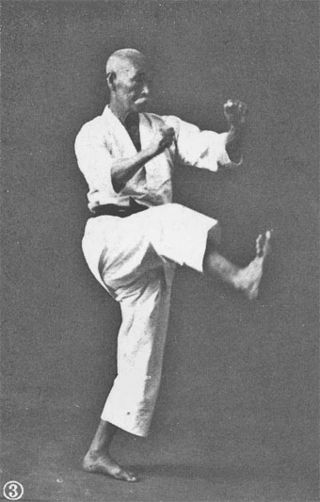
Karate (空手), also karate-do, is a martial art developed in the Ryukyu Kingdom. It developed from the indigenous Ryukyuan martial arts under the influence of Chinese martial arts. While modern karate is primarily a striking art that uses punches and kicks, traditional karate training also employs throwing and joint locking techniques. A karate practitioner is called a karate-ka (空手家).

Shotokan is a style of karate, developed from various martial arts by Gichin Funakoshi (1868–1957) and his son Gigo (Yoshitaka) Funakoshi (1906–1945). Gichin Funakoshi was born in Okinawa and is widely credited with popularizing "karate do" through a series of public demonstrations, and by promoting the development of university karate clubs, including those at Keio, Waseda, Hitotsubashi (Shodai), Takushoku, Chuo, Gakushuin, and Hosei.
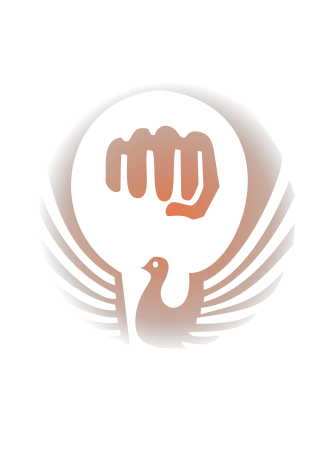
Wadō-ryū (和道流) is one of the four major karate styles and was founded by Hironori Ōtsuka (1892–1982). Ōtsuka was a Menkyo Kaiden licensed Shindō Yōshin-ryū practitioner of Tatsusaburo Nakayama and a student of Yōshin-ryū prior to meeting the Okinawan karate master Gichin Funakoshi. After having learned from Funakoshi, and after their split, with Okinawan masters such as Kenwa Mabuni and Motobu Chōki, Ōtsuka merged Shindō Yōshin-ryū with Okinawan karate. The result of Ōtsuka's efforts is Wadō-ryū Karate.
The Japan Karate Association is one of the oldest global Shotokan karate organizations in the world.
Shotokai is the organisation formed originally in 1930 by master Gichin Funakoshi to teach and spread the art of karate-Do. Nowadays, the name also designates a formal practice method.
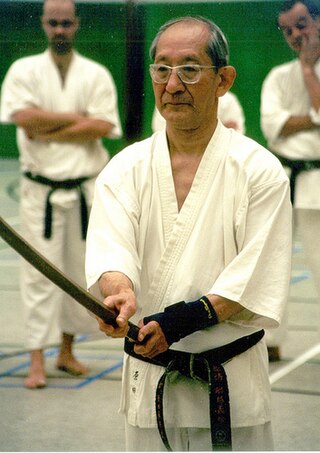
Mitsusuke Harada, MBE was a prominent Japanese master of Shotokai karate who introduced this martial art to Brazil and was after based in the United Kingdom. He founded the Karate-do Shotokai (KDS) organisation in 1965 and was its president. Harada held the rank of 5th dan, personally awarded by Gichin Funakoshi in 1956.

Tsutomu Ohshima[a] is a prominent Japanese master of Shotokan karate who founded the organization Shotokan Karate of America (SKA). He is the Shihan of the SKA, and to this day holds the rank of 5th dan, which was awarded to him by Gichin Funakoshi. Ohshima's branch of the Shotokan world has become known as “Shotokan Ohshima Karate-do.”
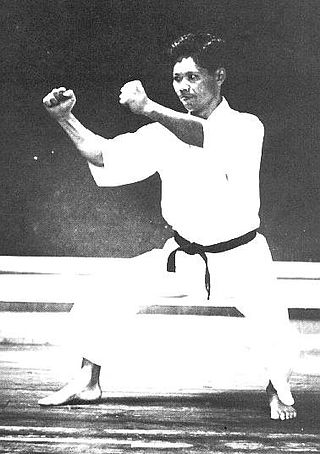
Gigō Funakoshi was the third son of Gichin Funakoshi and is widely credited with developing the foundation of the modern karate Shotokan style.
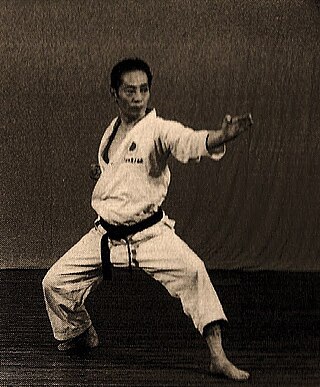
Tetsuhiko Asai was a prominent Japanese master of Shotokan karate of the Japan Karate Association (JKA), founder and Chief Instructor of the International Japan Martial Arts Karate Asai-ryu (IJKA), and founder of the Japan Karate Shoto Federation.
Shudokan, literally "the hall for the study of the way of karate," is a Japanese school of karate developed by Kanken Toyama . It was the total headquarters of Japan Karate Federation (old). Characteristics of Shudokan karate include large circular motions with an emphasis on covering and its own unique kata.

Gichin Funakoshi was the founder of Shotokan karate. He is known as a "father of modern karate". Following the teachings of Anko Itosu and Anko Asato, he was one of the Okinawan karate masters who introduced karate to the Japanese mainland in 1922, following its earlier introduction by his teacher Itosu. He taught karate at various Japanese universities and became honorary head of the Japan Karate Association upon its establishment in 1949. In addition to being a karate master, Funakoshi was an avid poet and philosopher. His son, Gigō Funakoshi, is widely credited with developing the foundation of the modern karate Shotokan style.

Teruyuki Okazaki, was a tenth degree black belt in Shotokan Karate, as well as the founder and chief instructor of the International Shotokan Karate Federation (ISKF). Along with Gichin Funakoshi and Masatoshi Nakayama, Okazaki helped found the Japan Karate Association's instructor training program.
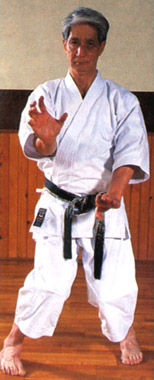
Hidetaka Nishiyama was a prominent Japanese master of Shotokan karate. He was an internationally recognized instructor, author, and administrator, and helped to establish the Japan Karate Association. Nishiyama was one of the last surviving students of Gichin Funakoshi, founder of Shotokan karate. He was based in the United States of America from 1961 until his death in 2008, and was a pioneer of karate in that country. He had been posthumously awarded the rank of 10th dan in karate.

Yutaka Yaguchi was a Japanese karateka who was the Chief Instructor and Chairman of the International Shotokan Karate Federation (ISKF) Mountain States Region. He was born in Hiroshima, Japan, in 1932 and began karate training in 1952. He later tested under masters Gichin Funakoshi for his 1st dan black belt and Masatoshi Nakayama for his 2nd through 8th dan black belts. As one of the first graduates of the Japan Karate Association (JKA) Instructors' Training Program in 1959, he played an important role in the growth of JKA karate and the internationalization of Shotokan karate. Yaguchi first arrived in the United States on June 5, 1965. In 1974, Yaguchi founded the ISKF of Colorado, the regional headquarters for the Mountain States Region.

Kenkojuku is a style of Shotokan karate previous to the establishment of the Japan Karate Association (JKA) style. It was founded by Tomosaburo Okano. Kenkojuku karate is similar to the teachings of Gichin Funakoshi and modifications made by Funakoshi's son Yoshitaka Funakoshi. JKA Shotokan differs slightly in that it was Masatoshi Nakayama's version of Shotokan. Okano's/Yoshitaka's Kenkojuku karate and JKA karate are becoming more similar compared to other variants of Shotokan karate such as Shigeru Egami's Shotokai, Hirokazu Kanazawa's Shotokan Karate International or SKI.
Toyotaro Miyazaki was a Japanese martial artist.

Taiji Kase was a Japanese master of Shotokan karate who was one of the earliest masters responsible for introducing this martial art into Europe. He taught his style of karate, Shotokan Ryu Kase Ha, in France from the late 1960s to the mid-1980s. In his later years, he travelled across the world teaching karate, but Paris remained his home. Kase held the rank of 9th dan in karate.
Isao Obata was a pioneering Japanese master of Shotokan karate. He was a senior student of Gichin Funakoshi, who is widely recognized as the founder of modern karate, and was a key figure in the establishment of the Japan Karate Association (JKA) under Funakoshi in 1949. Obata also helped introduce karate to the United States of America through his demonstrations of the art to United States Air Force personnel, and through his students, most notably Tsutomu Ohshima.
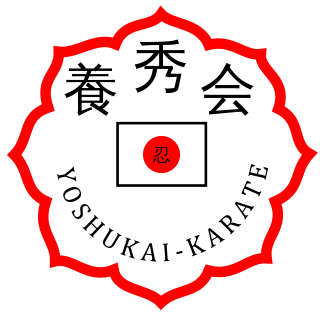
Yoshukai is a Japanese style of Karate–dō. Karate-do. Karate-do translates as "Way of the Empty Hand." The three kanji that make up the word Yoshukai literally translate as "Training Hall of Continued Improvement." However, the standardized English translation is "Striving for Excellence." Yoshukai Karate has been featured in Black Belt Magazine. Yoshukai karate is a separate Japanese style from Chito-ryu. Kata, kobudo, kumite, and all karate aspects are drawn from the Founder, Mamoru Yamamoto. Yoshukai is a newer derivative Japanese style.













